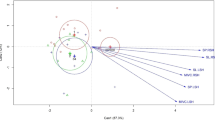Abstract
The article discusses the usefulness and technique of investigation of suspected psychogenic dysphagia by surface electromyography (sEMG) of deglutition. Thirty-two patients with suspected psychogenic dysphagia (Group 1) and 40 healthy individuals (Group 2) were involved in the study. The timing, amplitude and graphic patterns of activity of the masseter, submental, infrahyoid and trapezius muscles were examined during voluntary single water swallows (“normal”), and continuous drinking of 100 cc of water. The muscle activity in oral, pharyngeal and initial oesophageal stages of swallowing was measured, and graphic records were evaluated in relation to timing and voltage. Globus hystericus was found in only 14 patients of the Group 1 (43.75%). The main sEMG pattern of psychogenic dysphagia is a lack of any pathologic changes of timing, voltage and graphic patterns of deglutition. In 28% of cases tension of skeletal muscles not involved in deglutition was observed during single swallowing (vs. 0% in controls). Psychogenic/hysteria-conversion dysphagia has no pathologic sEMG patterns associated with deglutition. Skeletal muscle tension during deglutition, being observed in some cases has no connection with the act of swallowing itself. Surface EMG, being non-invasive and non-radiographic, can be used for screening purposes for patients with dysphagia thus avoiding expensive and time-consuming investigation.



Similar content being viewed by others
References
Baker ME, Zuccaro G, Achkar E, Rice TW (1999) Oesophageal diverticula: patient assessment. Semin Thorac Cardiovasc Surg 11:326–336
Tokashiki R, Yamaguchi H, Nakamura K et al (2002) Globus sensation caused by gastroesophageal reflux disease. Auris Nasus Larynx 29(4):347–351
Webb CJ, Makura ZG, Fenton JE et al (2000) Globus pharyngeus: a postal questionnaire survey of UK ENT consultants. Clin Otolaryngol 25(6):566–569
Logemann JA (1994) Non-imaging techniques for the study of swallowing. Acta Otorhinolaryngol Belg 48:139–142
Gupta V, Reddy NP, Canilang EP (1996) Surface EMG measurements at the throat during dry and wet swallow. Dysphagia 11:173–179
Vaiman M, Eviatar E, Segal S (2004) Evaluation of stages of normal deglutition with the help of rectified surface electromyography records. Dysphagia 19(2):125–132
Vaiman M, Eviatar E, Segal S (2004) Surface electromyographic studies of swallowing in normal subjects: a review of 440 adults. Report 1: quantitative data–timing measures. Otolaryngol Head Neck Surg 131(4):548–555
Vaiman M, Eviatar E, Gabriel CH, Segal S (2005) Rectified and filtered surface electromyography of continuous drinking in healthy adults. Laryngoscope 115(1):68–73
Vaiman M, Eviatar E, Segal S (2004) Surface electromyographic studies of swallowing in normal subjects: a review of 420 adults. Report 2: quantitative data–amplitude measures. Otolaryngol Head Neck Surg 131(5):773–780
Vaiman M, Eviatar E, Segal S (2004) Surface electromyographic studies of swallowing in normal subjects: a review of 440 adults. Report 3: qualitative data. Otolaryngol Head Neck Surg 131(6):977–985
Wilbourn AJ (1995) The electrodiagnostic examination with hysteria-conversion reaction and malingering. Neurol Clin 13(2):385–404
First MB, Spitzer RL, Gibbon M, Williams JB (1995) Structured clinical interview for DSM-IV axis I disorders–patient edition, version 2. Biometric Research Department, New York
Vaiman M (2006) Surface electromyography in preoperative evaluation and postoperative monitoring of Zenker’s diverticulum. Dysphagia 21:1–7
Vaiman M, Krakovsky D, Eviatar E (2006) The influence of tonsillitis on oral and throat muscles in children. Int J of Pediatr Otorhinolaryngol 70(5):891–898
Vaiman M, Nahlieli O, Eviatar E, Segal S (2005) Electromyography monitoring of patients with salivary gland diseases. Otolaryngol Head Neck Surg 133(6):869–873
Vaiman M (2007) Standardization of surface electromyography utilized to evaluate patients with dysphagia. Head Face Med 3:26
Author information
Authors and Affiliations
Corresponding author
Rights and permissions
About this article
Cite this article
Vaiman, M., Shoval, G. & Gavriel, H. The electrodiagnostic examination of psychogenic swallowing disorders. Eur Arch Otorhinolaryngol 265, 663–668 (2008). https://doi.org/10.1007/s00405-007-0519-2
Received:
Accepted:
Published:
Issue Date:
DOI: https://doi.org/10.1007/s00405-007-0519-2




